Exhibition of paintings by Ljerka Filakovac
Exhibition concept: Nada Premerl
Exhibition design: Joža Ladović
 I have never tried to force any specific style or direction on to my work.
I have never tried to force any specific style or direction on to my work.
It is my opinion that my personality has been reflected freely in my artistic works, that my paintings are me myself, that they speak clearly about my life and ambience of the place where I live, about my existence in this world, about my talent and knowledge which I obtained in that sense.
I am acting with an artist's brush, with paint, chalk, goose's pen, aquarelle or pastel.
I never asked myself why I paint just as a bird never asks itself why it flies. First impressions about the life came from the paintings around me in our family house: my father at a painting stand with a palette in his hand, for me a charm with an agreable and important fragrance of the paintings. This experiance was shared by my two brothers and sister all of whom are artists.
From our early childhood all of us were able to paint in our father's studio, everywhere in the house as well as in the garden. There in our garden were birds and different domestic animals and even some wild ones.
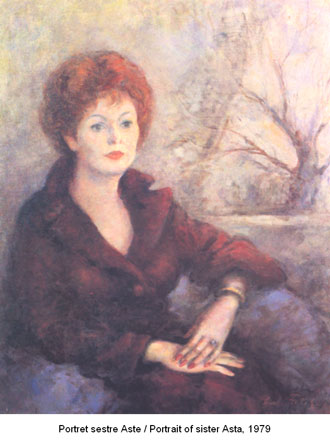 I was educated to love the life and nature which always was an indivisible part of my personality as well as a part of the achievements and traditions in the art which I received through my father (a respected artist and a professor at the Fine Art Academy) and through the artistic society where I lived. I would say in my works I gave an optimistic view of the world, even in matters concerning the death and the sorrow.
I was educated to love the life and nature which always was an indivisible part of my personality as well as a part of the achievements and traditions in the art which I received through my father (a respected artist and a professor at the Fine Art Academy) and through the artistic society where I lived. I would say in my works I gave an optimistic view of the world, even in matters concerning the death and the sorrow.
My painting is generally very close to the auditorium. So, example gratia, famous Rembrandt or Beethoven were understandable to everybody. They did not need any interpreter for their art.
It is after Christ that the ages are calculated, his teaching is so simple and genuine and so tremendous in its truth. Love, beauty, nobility and humanitarianism are not only verbal symbols, behind those words there are deep seated human needs, needs which are millenia old. The mankind need the hope in order to live while the artists through their works are obliged at least to uphold that hope.
Ljerka Filakovac

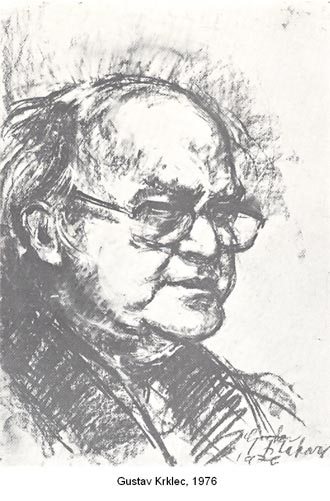 Long time ago, some twenty years, opening an interesting exhibition of Vladimir Filakovac's children in Belgrade Art Pavillion, I had no illusion about “wunderkinder”, but interpreted natural talent, spontaneity of expression and colour sensitivity of the artist's children, Ljerka's among them, as a voice of early born, internal need for the expression of artistic experience, stimulated some more by the special circumstances that the children lived and grew up in an bohemian studio environment of their father, among canvases and palettes, trestles and brushes, oils and painted chalks, thus giving them a chance, so early in life and so abundantly, to develop and enrich their innate affinity towards art.
Long time ago, some twenty years, opening an interesting exhibition of Vladimir Filakovac's children in Belgrade Art Pavillion, I had no illusion about “wunderkinder”, but interpreted natural talent, spontaneity of expression and colour sensitivity of the artist's children, Ljerka's among them, as a voice of early born, internal need for the expression of artistic experience, stimulated some more by the special circumstances that the children lived and grew up in an bohemian studio environment of their father, among canvases and palettes, trestles and brushes, oils and painted chalks, thus giving them a chance, so early in life and so abundantly, to develop and enrich their innate affinity towards art.
I remember well, that even a master as Petar Dobrović has then talked with a lot of praise and exaltation about this child's artistic acomplishments, which maybe did not belong to a cathegory of “pure art”, but were extremely interesting both as a fact and as a testimony and, in some cases, even as a high acomplishment of child's creative abilities. From that relatively short, although distant time period of two decades, I have lost from my sight the children of my old friend Vladimir Filakovac, while only a few Ljerka's paintings or graphics, in an encounter, corroborated me in my conviction, that the very same “child's flame” was not extinguished, as the case usually is with a “winderkind”, but on the contrary, from the gifted child even more talented artist has been developed, who toward her life's vocation relates with a lot of love, conscience and seriousness.
Gustav Krklec
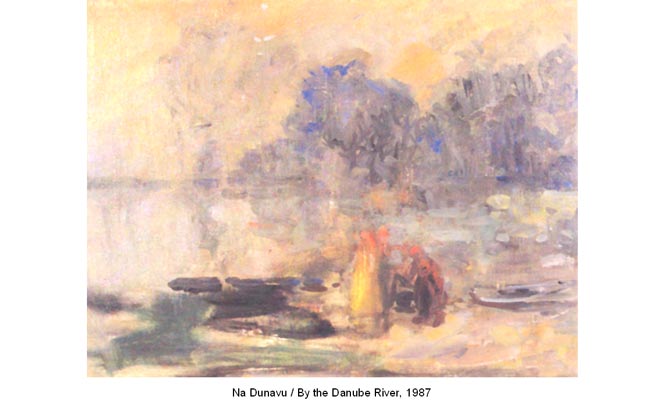
 Slavonian by origin. Slavonia means the richness of the land, instinct, and character. Slavonia means freedom too. The swamps, the forests, the waters, the plains and the hunting grounds which are a constant base if inspiration of Vlado Filakovac, remained an opssesion of his daughter. Genes are not only a physiological indicator of origin, but a moral one as well. Because of this, the spontaneity of life and nature did not find in Ljerka just an original interpretor but also a creative competitor.
Slavonian by origin. Slavonia means the richness of the land, instinct, and character. Slavonia means freedom too. The swamps, the forests, the waters, the plains and the hunting grounds which are a constant base if inspiration of Vlado Filakovac, remained an opssesion of his daughter. Genes are not only a physiological indicator of origin, but a moral one as well. Because of this, the spontaneity of life and nature did not find in Ljerka just an original interpretor but also a creative competitor.
Ljerka Filakovac has traveled a lot. Invited to point portraits, she has seen half a Europe, seen a lot, learnt and by painting noted it. Sometimes the motifs were from architecture, or some street, a face or a pictoresque group; always something that was imposed upon her either as beauty or character. The landscape makes her gay, nature morte caresses, the world of animals is the world of her pets, but the mystery of man is the one thing that attracts her most and she deals with it most often. What she seeks is the invisible, human, individual and animal, concentrated under the membrane of the surface of which becomes strung by the growing of the inside, which is contracted, shaped and stylized, revealing its content more to the intuitive spirit and less to an analytical eye.
To capture this invisible by the movement of the pen, crayon and brush is Ljerka's passion by which links her with the tradition of all the great. “Disegnare, disegnare, disegnare” – to paint, to paint and to paint is a big lecture of great Tintoretto to German painters when they asked him what is needed for a painter to become a good painter. Ljerka too, as you can see, now paints the world of optical reality on the edge of premonition, the next moment the world of secrets, the world of largest span and richest emotion.
Andro-Vid Mihičić

Before of saying anything about roatian paintress Ljerka Filakovac, we have to say this: Ljerka Filakovac is a real artist. This means that the said person is fatefully bound with the painting phenomenon. And further that means: the mentioned paintress does not paint only, for the reason of being a paintress by profession, but she paints essentially, because she has to paint. By her an act of painting goes over almost the psychological border and is almost her physical expression, of the life in general. To take the colours away from her, I do not know what Ljerka could consider as a sense of existence.
The case really exceptional in our contemporary painting! Namely, today we are the eye-witnesses of the converse relation against the act of painting and the art in generally. Maybe only two, three, among hundreds of our painters, have that deep organic reference against the act of an artistic creation. There are few to whom the painting is the problem of personality and a spiritual motion, equilibrium of corporality.
Matko Peić
 Ljerka Filakovac by her exposition does not surprise the visitors with the new admissions to the theme, she is always recognizable, while from an exposition to the other one – we can establish only, that Ljerka paints better and better. First of all, she knows exceptionally the material she deals with, regardless of oil, ink chalk or shaded ink. Even when the line is drawn with a tiny pen, the line is steady and firm, meanwhile when with a few stains of shaded ink contrapunctuates light and shadow, she attains remarkable sensibility and achieves corresponding atmosphere.
Ljerka Filakovac by her exposition does not surprise the visitors with the new admissions to the theme, she is always recognizable, while from an exposition to the other one – we can establish only, that Ljerka paints better and better. First of all, she knows exceptionally the material she deals with, regardless of oil, ink chalk or shaded ink. Even when the line is drawn with a tiny pen, the line is steady and firm, meanwhile when with a few stains of shaded ink contrapunctuates light and shadow, she attains remarkable sensibility and achieves corresponding atmosphere.
Ljerka Filakovac is interested in everything what surrounds her, but above all, I suppose, she takes interest in a human. So, at any her exposition one can see a few portraits where not only a skilled master is discovered, but an artist who desires to penetrate in a pith of the portraid person.
Marina Baričević

The subtlety of motion with which she builds her artistic achievements, together with the nobliness of the colour which she uses – have aligned Ljerka Filakovac among our most poetic painters. Continuing the tradition of the realistic and emotive in Croatian art, she (after schooling in her father's, Vladimir Filakovac's, studio and on an Academy of Arts where she got her degree in Zagreb, in 1952) builds her stylistics of lirical noting of immediate contacts with nature. She tried her hand at almost all themes and techniques, from portrait and figurative art to landscape and urban atmosphere, from oil and tempera to pastel and ink. In this exuberance of motifs, however, one of the honorary places belongs to atmospheres connected with water.
As a Slavonian, she carried with herself from her native land, the attachment to expanses where plants and swamps merge into a new enchanting organism. They become the realms of dreams in which mist sweeps away the sharpness of the form and the imagination in gentle steaming units the game of the shadows. In these compositions, the sigh quivers while the time stands still in unreachable states of the primeval. In such a frame of origin nature, the excitements burst into flames, emotions dissolve and thoughts reveal. The artist is identified with the rudiments, to prophesy, in lirical presentiments of life's birth, the beauty, the peace and the plentitude.
Juraj Baldani
(from the exhibition catalogue)
Pictures from the exhibition
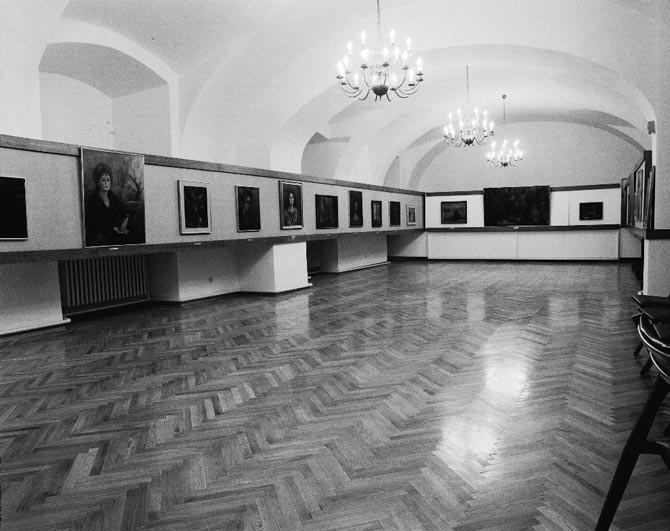
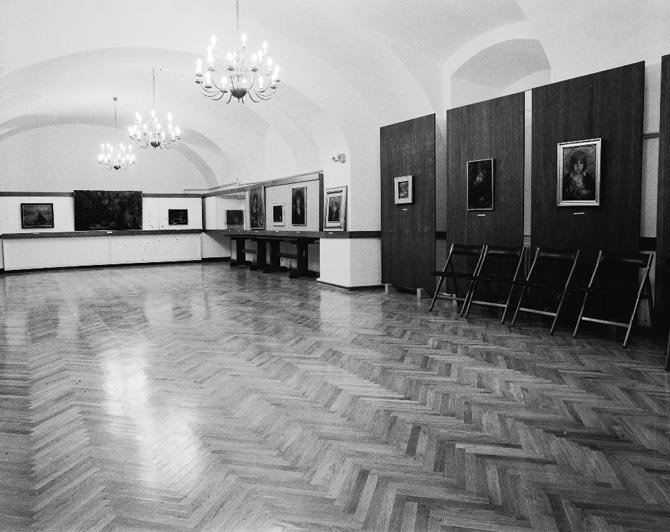

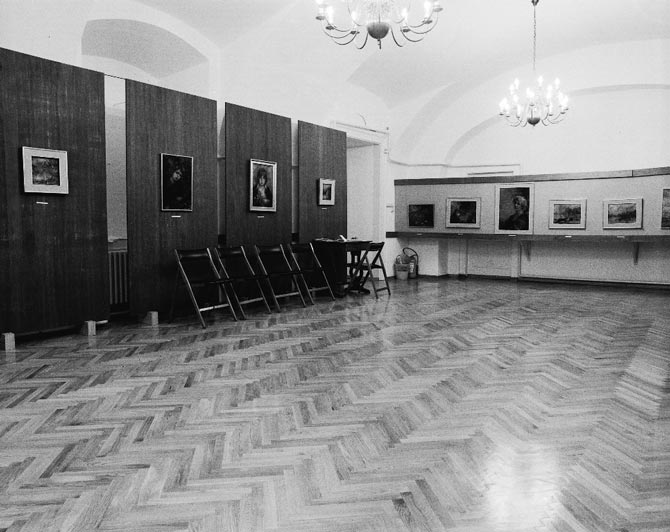
photo Josip Vranić, ZCM
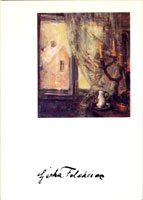 Exhibition catalogue
Exhibition catalogue
Ljerka Filakovac.
Zagreb : Grafički zavod Hrvatske, 1987

